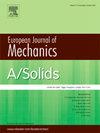Tilted indentation by a flat-ended punch on an anisotropic magnetoelectroelastic half-plane
IF 4.4
2区 工程技术
Q1 MECHANICS
引用次数: 0
Abstract
We present closed-form solutions for the indentation of a tilted flat-ended punch with an anisotropic magnetoelectroelastic half-plane. The punch is subjected to a load P at an eccentricity e and the electric charge Ε and magnetic charge I at the same time. The analytical solutions are obtained by utilizing the expanded Stroh formalism for magnetoelectroelastic materials alongside the analytical continuation method. By leveraging Stroh's approach, the general solutions to the problems are expressed in terms of complex variable techniques, which facilitate a comprehensive analysis of the coupled mechanical, electrical, and magnetic fields. The analytical continuation method is utilized to address contact boundary conditions introduced by the tilted punch, enabling the derivation of solutions for stress, electric displacement, and magnetic induction within the half-plane. The punch considered here is flat-ended, and the contact is frictionless. Four electric and magnetic contact conditions are examined. The relations between applied load, electric charge, magnetic charge, angle, and eccentricity of punch are presented in closed-form matrix expressions. As to the case of electric and magnetic insulators, the relation will be further simplified and expressed explicitly in a scalar form. We found that the eccentricity limit and tilted angle limit depend complicatedly on the anisotropic MEE material properties for the cases of (1) electric and magnetic conductor, (2) electric insulator and magnetic conductor, and (3) electric conductor and magnetic insulator. For the case of an electric and magnetic insulator, the eccentricity limit is equal to a/2, where a is the half-width of the punch, which is the same as that of isotropic elastic material. To demonstrate the correctness and versatility of our derived solutions, several numerical examples are provided. Based on the results provided, comprehensive parametric studies on the effects of anisotropic material properties and loadings are also studied and discussed.
平头冲头在各向异性电磁弹性半平面上的倾斜压痕
本文给出了具有各向异性磁电弹性半平面的倾斜平端冲床压痕的闭合解。冲床同时受到偏心率e的载荷P和电荷Ε和磁荷I的作用。利用磁电弹性材料的扩展Stroh形式和解析延拓方法得到了解析解。通过利用Stroh的方法,问题的一般解决方案以复杂变量技术的形式表示,这有助于对耦合的机械、电气和磁场进行全面分析。利用解析延拓法求解倾斜冲床引入的接触边界条件,推导出半平面内应力、电位移和磁感应的解。这里考虑的冲头是平的,接触是无摩擦的。考察了四种电、磁接触条件。将外加载荷、电荷、磁荷、角度和冲床偏心之间的关系以封闭矩阵形式表示出来。对于电绝缘子和磁绝缘子,这种关系将进一步简化,并以标量形式明确表示。研究发现,在(1)电和磁导体、(2)电绝缘子和磁导体、(3)电导体和磁绝缘子三种情况下,偏心率极限和倾角极限与MEE材料的各向异性有复杂的关系。对于电磁绝缘体,偏心极限为a/2,其中a为凸模的半宽度,与各向同性弹性材料相同。为了证明我们推导的解的正确性和通用性,给出了几个数值算例。在此基础上,对各向异性材料性能和载荷影响的综合参数研究也进行了研究和讨论。
本文章由计算机程序翻译,如有差异,请以英文原文为准。
求助全文
约1分钟内获得全文
求助全文
来源期刊
CiteScore
7.00
自引率
7.30%
发文量
275
审稿时长
48 days
期刊介绍:
The European Journal of Mechanics endash; A/Solids continues to publish articles in English in all areas of Solid Mechanics from the physical and mathematical basis to materials engineering, technological applications and methods of modern computational mechanics, both pure and applied research.

 求助内容:
求助内容: 应助结果提醒方式:
应助结果提醒方式:


